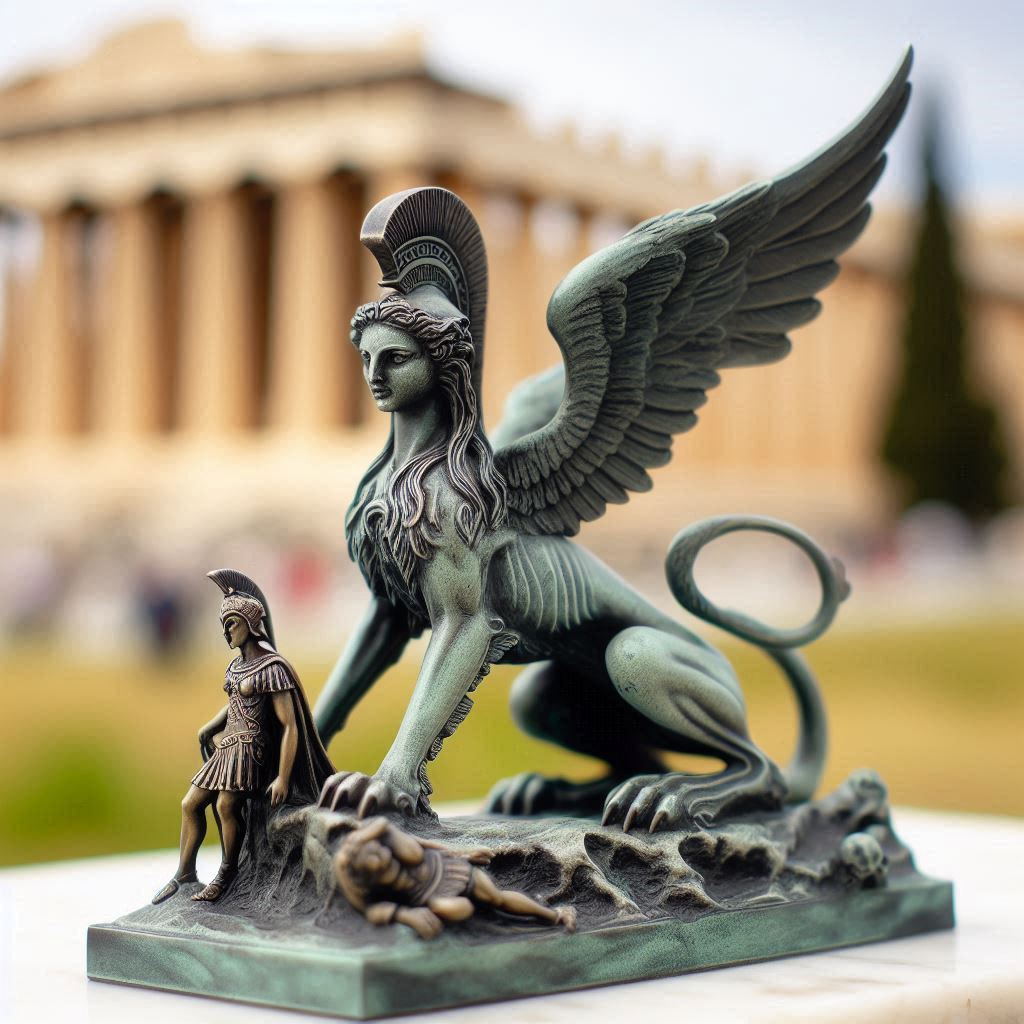Introduction
The Sphinx is one of the most enigmatic and enduring creatures from Greek mythology, often depicted as a winged creature with the body of a lion and the face of a woman. Best known for her role in the myth of Oedipus, the Sphinx was notorious for her deadly riddles. This blog explores the origins, myth, and symbolism surrounding this ancient being and the lasting impact it has had on popular culture.
Origins of the Sphinx
The concept of the Sphinx predates Greek mythology, with its roots in ancient Egypt, where it was seen as a symbol of power and protection. The Greek version, however, is far more fearsome. In Greek mythology, the Sphinx was believed to be the daughter of Typhon and Echidna, both formidable creatures themselves. Unlike her Egyptian counterpart, who was a guardian figure, the Greek Sphinx was a menacing presence, known for challenging anyone who crossed her path with a deadly riddle.
The Sphinx in Greek Mythology
In Greek myth, the Sphinx was sent by the gods (some versions say by Hera) to terrorize the city of Thebes. The creature would sit perched on a rock, blocking the path to the city and posing a riddle to travelers. Those who failed to answer correctly would meet a gruesome fate, as the Sphinx would devour them. This deadly guardian became a figure of fear, a literal roadblock to the prosperity of Thebes, until a young man named Oedipus arrived.

The Riddle of the Sphinx
The Sphinx is most famously associated with her riddle, which she asked all who sought to enter Thebes:
"What walks on four legs in the morning, two legs at noon, and three legs in the evening?"
The answer, as Oedipus correctly guessed, is "a human being" — crawling on all fours as a baby, walking on two legs as an adult, and using a cane in old age. Upon hearing the correct answer, the Sphinx is said to have thrown herself from her perch to her death, ending her reign of terror.
Oedipus and His Encounter with the Sphinx
Oedipus’s encounter with the Sphinx marks a pivotal moment in Greek mythology. His intelligence and quick thinking not only save Thebes from the Sphinx but also catapult him into the city as a hero. However, this victory is bittersweet, as it sets in motion the tragic events of his life, famously chronicled in the play Oedipus Rex by Sophocles. Oedipus’s triumph over the Sphinx is symbolic of the power of human intellect, but also serves as a reminder of the dark fate that awaits those who challenge the gods.
Symbolism of the Sphinx
The Sphinx represents various themes in Greek mythology, many of which revolve around mystery, intelligence, and fate. As a creature that guards a secret (the answer to her riddle), she symbolizes the unknown and the barriers that humans face in life. Her riddle, specifically, is a metaphor for the stages of human existence. The Sphinx's defeat by Oedipus, a mortal man, also highlights the tension between human intellect and divine will, a recurring theme in many Greek myths.

The Sphinx in Popular Culture
The Sphinx’s lasting legacy can be seen across many forms of modern media, from literature and art to films and video games. Her image is often used to represent challenges, puzzles, or obstacles that characters must overcome. The Sphinx continues to fascinate as a symbol of mystery, wisdom, and danger, with references to her appearing in works ranging from Harry Potter to Assassin’s Creed. She remains an iconic figure, representing the timeless struggle between man and the unknown.
Conclusion
The Sphinx is much more than a monster in Greek mythology; she is a symbol of the challenges that life presents and the human capacity to overcome them through intelligence and determination. Her story, particularly her interaction with Oedipus, has become a timeless myth that continues to captivate audiences. Whether as a symbol of mystery or as a guardian of knowledge, the Sphinx remains an enduring figure in both ancient and modern storytelling.
Interested in Greek mythology and history ? Click here

